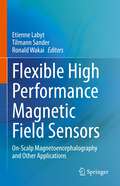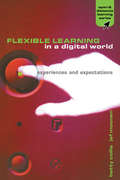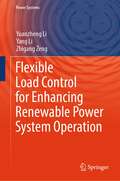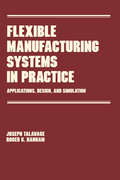- Table View
- List View
Flexible Fertigungssysteme: Simulation der Prozesse als Hilfsmittel zur Planung und zum Test von Steuerprogrammen (ISW Forschung und Praxis #57)
by Siegmund ChmielnickiFlexible Fertigungssysteme: Steuerung und Überwachung des Fertigungsablaufs (ISW Forschung und Praxis #37)
by W. DöttlingFlexible Fertigungssysteme: Entwicklung und Erprobung eines zentralen Steuersystems (ISW Forschung und Praxis #38)
by J. FirnauFlexible Fertigungssysteme: Entwurf und Realisierung prozeßnaher Steuerungsfunktionen (ISW Forschung und Praxis #39)
by A. HerrscherFlexible Fertigungssysteme: Der FFS-Report der INGERSOLL ENGINEERS (IPA-IAO - Forschung und Praxis Tagungsberichte #1)
by H. J. WarneckeFlexible Fertigungssysteme eröffnen den Unternehmen rasche und gezielte Reaktionen aufvielfältige Herausforderungen im Wettbewerb wie steigende Kosten, veränderliche Nachfrage und termingerechte Lieferung. Bei der Einführung von flexiblen Fertigungssystemen treten in der Regel betrieb liche und unternehmerische Reorganisationsprobleme auf, die die Firmen oft nicht aus eigener Erfahrung sondern nur mit einer umfassenden und so liden Information über diese neue Technik von außen lösen können. Der Aufbau eines solchen Informationsnetzes kann zudem oft schon zu einer realistischen Sicht gegenüber der neuen Technologie und zum Abbau von unangemessenen Befürchtungen führen, die mit ihrer Einführung bei Be troffenen verbunden sind. Ich begrüße es deshalb, daß es mit der Herausgabe eines deutschen "FMS-Reports" auch der deutschen Industrie leichter gemacht wird, sich fundiert über dieses wichtige Instrument zu informieren. Die Bedeutung der automatischen flexiblen Fertigung kann für die Erhaltung und Stärkung der Wettbewerbsfähigkeit unserer Wirtschaft nicht hoch genug eingeschätzt werden. Nur durch die Entwicklung und Anwendung von Spitzentechniken und umfangreichem Fertigungs-know-how wird es der Bundesrepublik ge lingen, ihre Exportfähigkeit und Weltmarktstellung und damit Arbeits plätze zu sichern.
Flexible Fertigungssysteme: 20. IPA-Arbeitstagung 13./14. September 1988 in Stuttgart (IPA-IAO - Forschung und Praxis Tagungsberichte #10)
by Hans-Jürgen WarneckeUm erfolgreich zu sein gilt es, rechtzeitig die strategischen Entscheidungen in den Unter nehmen zu treffen und die erfolgbestimmenden Weichen für die Zukunft richtig zu stellen. Daß mit flexiblen Fertigungssystemen bei fundierter Planung Vorteile in stra tegischer und operativer Hinsicht verbunden sind, dürfte heute außer Zweifel stehen. Diese Vorteile können noch verstärkt werden, wenn die Systeme nicht als reine Fertigungsanlagen geplant und betrieben, sondern als Teil eines Gesamtbetriebes, und damit als vollwertiger Baustein der Rechnergeführten Produktion (CIM) gesehen werden. Die damit verbundenen Aufgaben, die sich durch die vertikale wie auch horizontale I ntegration eines flexiblen Fertigungssystems in den Gesamtbetrieb ergeben, werden oft erst beim Systembetrieb erkannt. Diese dann noch zu lösen, fällt häufig schwer - dies muß bereits während der Planung geschehen. Für viele Unternehmer, vor allem Klein-und Mittelbetriebe, werden die auf diesem Weg notwendigen Entscheidungen zu Hürden, die alleine nicht zu bewältigen sind. Schon die vergleichende Bewertung von verschiedenen Herstellerangeboten von Werkzeug maschinen, Materialflußsysteme, Steuerungshard-und software stellt für den Anwender eine große Herausforderung dar. Tagungen können dabei eine wichtige Mittierfunktion einnehmen, um unverzichtbare Informationen aus erster Hand zu erhalten und um wertvolle Erfahrungen auszutauschen, die alle selbst zu sammeln jedes einzelne Unternehmen teuer, vielleicht zu teuer zu stehen kämen. Mit der 20. IPA -Arbeitstagung "Flexible Fertigungssysteme" wird die erfolgreiche internationale Tagungsreihe "Flexible Manufacturing Systems" (FMSl, die bereits im siebten Jahr stattfindet, mit der ebenfalls im fünften Jahr stattfindenden Tagungsreihe "Lasers in Manufacturing" (UM) erstmals zu einem internationalen Doppelkongreß zusammengeführt.
Flexible Flat Panel Displays (Wiley Series in Display Technology)
by Dirk J. Broer Gregory P. Crawford Darran R. CairnsFlexible Flat Panel Displays A complete treatment of the entire lifecycle of flexible flat panel displays, from raw material selection to commercialization In the newly revised Second Edition of Flexible Flat Panel Displays, a distinguished team of researchers delivers a completely restructured and comprehensive treatment of the field of flexible flat panel displays. With material covering the end-to-end process that includes commercial and technical aspects of the technology, the editors have included contributions that introduce the business, marketing, entrepreneurship, and intellectual property content relevant to flexible flat panel displays. This edited volume contains a brand-new section on case studies using the Harvard Business School format that discusses current and emerging markets in flexible displays, such as an examination of the use of electronic ink and QD Vision in commercial devices. From raw material selection to device prototyping, manufacturing, and commercialization, each stage of the flexible display business is discussed in this insightful new edition. The book also includes: Thorough introductions to engineered films for display technology and liquid crystal optical coatings for flexible displays Comprehensive explorations of organic TFT foils, metallic nanowires, adhesives, and self-healing polymer substrates Practical discussions of flexible glass, AMOLEDs, cholesteric displays, and electronic paper In-depth examinations of the encapsulation of flexible displays, flexible batteries, flexible flat panel photodetectors, and flexible touch screens Perfect for professionals working in the field of display technology with backgrounds in science and engineering, Flexible Flat Panel Displays is also an indispensable resource for professionals with marketing, sales, and technology backgrounds, as well as senior undergraduates and graduate students in engineering and materials science.
Flexible Flat Panel Displays (Wiley Series in Display Technology)
by Darran R. Cairns Dirk J. Broer Gregory P. CrawfordFlexible Flat Panel Displays A complete treatment of the entire lifecycle of flexible flat panel displays, from raw material selection to commercialization In the newly revised Second Edition of Flexible Flat Panel Displays, a distinguished team of researchers delivers a completely restructured and comprehensive treatment of the field of flexible flat panel displays. With material covering the end-to-end process that includes commercial and technical aspects of the technology, the editors have included contributions that introduce the business, marketing, entrepreneurship, and intellectual property content relevant to flexible flat panel displays. This edited volume contains a brand-new section on case studies using the Harvard Business School format that discusses current and emerging markets in flexible displays, such as an examination of the use of electronic ink and QD Vision in commercial devices. From raw material selection to device prototyping, manufacturing, and commercialization, each stage of the flexible display business is discussed in this insightful new edition. The book also includes: Thorough introductions to engineered films for display technology and liquid crystal optical coatings for flexible displays Comprehensive explorations of organic TFT foils, metallic nanowires, adhesives, and self-healing polymer substrates Practical discussions of flexible glass, AMOLEDs, cholesteric displays, and electronic paper In-depth examinations of the encapsulation of flexible displays, flexible batteries, flexible flat panel photodetectors, and flexible touch screens Perfect for professionals working in the field of display technology with backgrounds in science and engineering, Flexible Flat Panel Displays is also an indispensable resource for professionals with marketing, sales, and technology backgrounds, as well as senior undergraduates and graduate students in engineering and materials science.
Flexible Flat Panel Displays (Wiley Series in Display Technology)
by Gregory CrawfordFlexible displays are currently one of the most researched topics within the flat panel display community. They promise to change our display-centric world by replacing bulky rigid devices with those that are paper-thin and can be rolled away or folded up when not in use.The field of flexible flat panel displays is truly unique in the sense that it is interdisciplinary to the display community, combining basic principles from nearly all engineering and science disciplines.Organized to bring the reader from the component level, through display system and assembly, to the possible manufacturing routes Flexible Flat Panel Displays:* outlines the underlying scientific theory required to develop flexible display applications;* addresses the critical issues relating to the convergence of technologies including substrates, conducting layers, electro-optic materials and thin-film transistors;* provides guidance on flexible display manufacturing; and* presents market information and a chapter dedicated to future market trends of flexible flat panel displays.Flexible Flat Panel Displays is an essential tool for scientists, engineers, designers and business and marketing professionals working at all levels of the display industry. Graduate students entering the field of display technology will also find this book an excellent reference. The Society for Information Display (SID) is an international society, which has the aim of encouraging the development of all aspects of the field of information display. Complementary to the aims of the society, the Wiley-SID series is intended to explain the latest developments in information display technology at a professional level. The broad scope of the series addresses all facets of information displays from technical aspects through systems and prototypes to standards and ergonomics
Flexible Food Packaging: Questions and Answers
by Arthur HirschPackaging is an essential feature of modern life. The science and art of packaging is so vast that no single book or even a multivolume work could hope to cover the entire scope of topics, from Artwork to Zipper. This volume has selected some of the most commonly raised questions in the field of flexible packaging of food. No claim is made for comprehensive coverage of the field-nor even for an in-depth exploration of a limited number of topics. The novice should find sufficient material here to gain a broad understanding of flexible packaging. The expert's knowledge may be enriched by the case studies and the additional reading lists. The first topic covered is "Who needs packaging?" We conclude that everyone depends on packaging. Western civilization as we know it today would cease without modern packaging. The advantages of controlled atmosphere (CA) or modified atmosphere packaging (MAP are reviewed, especially as they apply to the preservation of meat cheese and produce. The need for a moisture and oxygen barrier is analyzed, and materials that provide these properties are presented. The legal aspects of packaging are confronted-including FDA and USDA oversight, EPA and toxic waste disposal, bar codes, and nutritional labeling. Machinery-especially form-fill-seal (ffs)-is covered in detail, and the influence of the computer on the modern packaging operation is discussed.
Flexible Forming for Fluid Architecture
by Arno PronkThis book on flexible formwork for fluid architecture is a multi-faceted research that covers a broad field: from design to material and technology, and from history to future developments. It offers a pragmatic approach that can be extended with more cases, materials, techniques and methods for fluid architecture, and provides a better understanding of the main aspects of fluid architecture and to help them find the most suitable combinations of all aspects.The book is a challenging experience with many new discoveries, including two patents: one on moulding of fluid surfaces and one on 3D printing of fibre–reinforced ice. It also features two world records: the larges span (30 meters) and the highest thin shell structure (30,5 meters) in ice as well as a method for the construction of a fully laminated shell structure in insulated glass.
Flexible Formprüfung umgeformter Blechteile (IPA-IAO - Forschung und Praxis #259)
by Berend OberdorferFlexible Glass: Enabling Thin, Lightweight, and Flexible Electronics (Roll-to-Roll Vacuum Coatings Technology)
by Sean M. GarnerThis book details flexible glass properties that enable use in emerging electronic and opto-electronic applications. Discussion includes flexible glass advantages compared to alternative substrate materials. Examples describe flexible glass in processes such as vacuum deposition, monolithic integration, printing, and roll-to-roll. Flexible glass demonstrations in emerging applications such as photovoltaics, flexible displays, and optical interconnects are also detailed. The reader will find in this unique book: Discussion of flexible glass processing and mechanical reliability. Demonstration of flexible glass in roll-to-roll (R2R) fabrication processes. Flexible glass substrate examples in displays, sensors, and photovoltaics. Flexible glass ecosystem description for identification of new applications.
Flexible Glass: Enabling Thin, Lightweight, and Flexible Electronics (Roll-to-Roll Vacuum Coatings Technology)
by Sean M. GarnerThis book details flexible glass properties that enable use in emerging electronic and opto-electronic applications. Discussion includes flexible glass advantages compared to alternative substrate materials. Examples describe flexible glass in processes such as vacuum deposition, monolithic integration, printing, and roll-to-roll. Flexible glass demonstrations in emerging applications such as photovoltaics, flexible displays, and optical interconnects are also detailed. The reader will find in this unique book: Discussion of flexible glass processing and mechanical reliability. Demonstration of flexible glass in roll-to-roll (R2R) fabrication processes. Flexible glass substrate examples in displays, sensors, and photovoltaics. Flexible glass ecosystem description for identification of new applications.
Flexible High Performance Magnetic Field Sensors: On-Scalp Magnetoencephalography and Other Applications
by Etienne Labyt Tilmann Sander Ronald WakaiThis contributed volume reviews the latest advances in all the new technologies currently developed for MagnetoEncephaloGraphy (MEG) recordings, as well as sensor technologies and integrated sensor arrays for on-scalp MEG. The book gives an account of the first MEG imaging studies and explores the new field of feasible, experimental paradigms of on-scalp MEG. This is an ideal book for engineers, researchers, and students in the neurosciences interested in MEG imaging.
Flexible Incentives for the Adoption of Environmental Technologies in Agriculture (Natural Resource Management and Policy #17)
by Frank Casey Andrew Schmitz Scott Swinton David ZilbermanFlexible Incentives for the Adoption of Environmental Technologies in Agriculture identifies and structures more flexible economic incentives for the achievement of environmental goals in agriculture. It provides a conceptual framework and presents case studies that analyze how flexible incentives can address environmental problems that are caused by agricultural production. The book brings together economists, agency personnel and political economists for the purpose of exploring how new cutting-edge economic tools could be developed and applied to environmental problems. The goal of the book is to complement and to expand the economic theory of environmental regulation and technology adoption with new research findings. The key theme of this book is the important role technology takes when addressing environmental problems. New technologies and technical development are broadly defined to include economic instruments, innovative ways to communicate environmental information, new economic institutions, and education. This book is designed for public and private policymakers, government analysts, teachers, researchers and students who specialize in the fields of natural resources, agricultural economics and environmental regulation. It provides a fresh perspective on what types of incentives may be used to lead us to the desired environmental outcomes and offers new ideas about the types of economic instruments that may achieve these outcomes.
Flexible Kalina Cycle Systems
by Tangellapalli Srinivas N. Shankar Ganesh R. ShankarThis volume provides a good understanding of the binary fluid system, highlighting new dimensions of the existing Kalina cycle system, a thermodynamic process for converting thermal energy into usable mechanical power. The book illustrates that providing new flexibility leads to new research outcomes and possible new projects in this field. The information provided in the book simplifies the application of the Kalina cycle system with an easy-to-understand and thorough explanation of properties development, processes solutions, sub-system work, and total system work. There are currently no books available in the area of binary fluid system in the field of KCS with added fallibility in the operation and process design. Currently decentralized power systems are gaining more attention due to shortages in power, and cooling demands are competing with other electrical loads. This book fills a valuable information gap, providing insight into a new dimension for designers, practicing engineers, and academicians in this area.
Flexible Kalina Cycle Systems
by Tangellapalli Srinivas N. Shankar Ganesh R. ShankarThis volume provides a good understanding of the binary fluid system, highlighting new dimensions of the existing Kalina cycle system, a thermodynamic process for converting thermal energy into usable mechanical power. The book illustrates that providing new flexibility leads to new research outcomes and possible new projects in this field. The information provided in the book simplifies the application of the Kalina cycle system with an easy-to-understand and thorough explanation of properties development, processes solutions, sub-system work, and total system work. There are currently no books available in the area of binary fluid system in the field of KCS with added fallibility in the operation and process design. Currently decentralized power systems are gaining more attention due to shortages in power, and cooling demands are competing with other electrical loads. This book fills a valuable information gap, providing insight into a new dimension for designers, practicing engineers, and academicians in this area.
Flexible Learning in a Digital World: Experiences and Expectations (Open and Flexible Learning Series)
by Collis, Betty Moonen, JefBetty Collis and Jef Moonen present a series of proven and practical guidelines, based on their balanced experience of using technology in education. Together, these give readers an overview of how technological applications in education can be developed and harnessed.
Flexible Learning in a Digital World: Experiences and Expectations (Open and Flexible Learning Series)
by Collis, Betty Moonen, JefBetty Collis and Jef Moonen present a series of proven and practical guidelines, based on their balanced experience of using technology in education. Together, these give readers an overview of how technological applications in education can be developed and harnessed.
Flexible Load Control for Enhancing Renewable Power System Operation (Power Systems)
by Yuanzheng Li Yang Li Zhigang ZengThis book addresses the pressing challenges faced by renewable power system operation (RPSO) due to the increasing penetration of renewable energy and flexible load. These challenges can be divided into two categories. Firstly, the inherent uncertainties associated with renewable energy sources pose significant difficulties in RPSO. Secondly, the presence of various types of flexible load, along with their complex constraint relationships, adds to the operational complexities. Recognizing the growing emphasis on the economic and low-carbon aspects of RPSO, this book focuses on the key issues of flexible load control. It mainly consists of following categories: (1) The control of data centers, a booming flexible load, to enhance RPSO through renewable energy integration and advanced robust multi-objective optimization. (2) The introduction of flexible industrial load control, employing effective demand-supply cooperative responding strategies for RPSO. (3) The exploration of electricvehicle flexible charging load control and centralized electric vehicle charging system control in the context of RPSO. The book also covers the emerging field of flexible integrated load control for renewable energy-based comprehensive energy system operation. Aimed at researchers, engineers, and graduate students in electrical engineering and computer science, this book provides a valuable resource for understanding and implementing flexible load control in the context of RPSO.
Flexible Manufacturing Systems in Practice: Design: Analysis and Simulation
by Joseph TalavageThis book has been written for all those interested in flexible manufacturing systems (FMS) and other forms of computerized manufacturing systems (CMS). It deals with many aspects of the design, operation, and simulation of FMS and explains the origins of FMS.
Flexible Manufacturing Systems in Practice: Design: Analysis and Simulation
by Joseph TalavageThis book has been written for all those interested in flexible manufacturing systems (FMS) and other forms of computerized manufacturing systems (CMS). It deals with many aspects of the design, operation, and simulation of FMS and explains the origins of FMS.



















